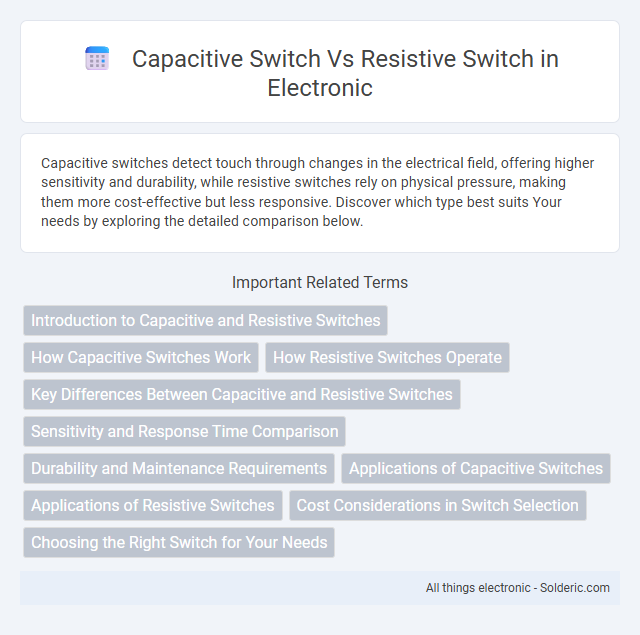Capacitive switches detect touch through changes in the electrical field, offering higher sensitivity and durability, while resistive switches rely on physical pressure, making them more cost-effective but less responsive. Discover which type best suits Your needs by exploring the detailed comparison below.
Comparison Table
| Feature | Capacitive Switch | Resistive Switch |
|---|---|---|
| Technology | Detects touch via change in capacitance | Detects pressure by measuring resistance change |
| Touch Sensitivity | High sensitivity; works with fingers | Requires physical pressure for activation |
| Durability | Long lifespan; no mechanical wear | More prone to wear due to physical contact |
| Accuracy | Precise touch detection | Less precise; pressure varies results |
| Environmental Resistance | Resistant to dust and moisture | Can be affected by dirt and liquids |
| Cost | Generally higher cost | Lower manufacturing cost |
| Common Uses | Smartphones, tablets, modern touch interfaces | Older touchscreens, simple control panels |
Introduction to Capacitive and Resistive Switches
Capacitive switches detect changes in capacitance caused by the presence of a finger or conductive object, offering high sensitivity and durability without requiring physical pressure. Resistive switches rely on mechanical pressure to connect two conductive layers, providing reliable input even when touched with gloves or styluses. Understanding the differences in responsiveness and operational mechanisms helps you choose the right switch technology for your device's interface needs.
How Capacitive Switches Work
Capacitive switches operate by detecting changes in capacitance when a conductive object, such as your finger, comes into proximity or touches the switch surface. These switches consist of an insulated electrode and a sensing circuit that measures the variation in the electric field caused by the conductive touch. Unlike resistive switches, capacitive technology relies on the body's natural capacitance, offering higher sensitivity and durability without physical pressure.
How Resistive Switches Operate
Resistive switches operate by detecting pressure applied to the screen, causing two conductive layers to make contact and register an input. The layers consist of a flexible top membrane and a rigid bottom layer, with the electrical circuit closing upon touch. This technology provides reliable input even when using gloves or styluses, making resistive switches suitable for harsh environments.
Key Differences Between Capacitive and Resistive Switches
Capacitive switches detect touch through changes in the electrostatic field using your finger, enabling faster response times and higher sensitivity compared to resistive switches, which rely on pressure applied to multiple layers. Capacitive switches offer greater durability and support multi-touch functionality, while resistive switches are typically more affordable and functional with any object, including styluses or gloves. Understanding these key differences can help you choose the ideal switch type for your device's touch interface needs.
Sensitivity and Response Time Comparison
Capacitive switches offer higher sensitivity by detecting changes in the electrostatic field, enabling faster response times typically under 10 milliseconds, which enhances user experience in touch interfaces. Resistive switches rely on pressure to register input, resulting in lower sensitivity and slower response times, often exceeding 20 milliseconds due to mechanical deformation. These differences make capacitive switches ideal for applications requiring rapid, precise input detection, while resistive switches are better suited for environments demanding durability and operation with gloves or stylus.
Durability and Maintenance Requirements
Capacitive switches offer superior durability with a lifespan often exceeding 10 million actuations due to their non-mechanical nature, reducing wear and tear. Resistive switches, relying on physical contact, tend to degrade faster under frequent use, typically lasting between 1 to 5 million actuations. Maintenance for capacitive switches is minimal since they are sealed and resistant to dust and moisture, whereas resistive switches require regular cleaning to prevent contact failures caused by dirt and debris accumulation.
Applications of Capacitive Switches
Capacitive switches are widely used in consumer electronics, including smartphones, tablets, and touch-sensitive control panels, due to their high sensitivity and durability. They are ideal for environments requiring sealed surfaces to prevent dust and moisture ingress, such as medical devices and industrial control systems. Their reliability in detecting proximity without physical pressure makes them suitable for automotive touch interfaces and home appliances.
Applications of Resistive Switches
Resistive switches are commonly used in environments where cost-effectiveness and durability are prioritized, such as industrial machinery, medical devices, and low-budget consumer electronics. Their ability to function with any pointing device makes them suitable for applications requiring gloves or stylus use, unlike capacitive switches that rely on direct skin contact. You can rely on resistive switches for precise input in harsh conditions, where moisture, dust, or contaminants might impair capacitive touchscreens.
Cost Considerations in Switch Selection
Capacitive switches often incur higher initial costs due to advanced materials and manufacturing processes, whereas resistive switches are typically more affordable and widely used in budget-sensitive applications. Your choice should consider not only upfront expenses but also durability and maintenance costs, with capacitive switches offering longer lifespans and lower failure rates. Evaluating total cost of ownership helps identify the best switch type for your project's financial and operational requirements.
Choosing the Right Switch for Your Needs
Capacitive switches offer high sensitivity and durability, making them ideal for modern touch interfaces where precision and responsiveness are crucial. Resistive switches provide reliable functionality under varying environmental conditions and can be operated with any object, including gloves or stylus, making them suitable for industrial applications. When choosing the right switch for your needs, consider the required touch accuracy, environmental factors, and the type of user interaction to ensure optimal performance and user experience.
capacitive switch vs resistive switch Infographic

 solderic.com
solderic.com